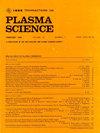Electrostatic Lenses for Laboratory Spacecraft Wake Generation
IF 1.3
4区 物理与天体物理
Q3 PHYSICS, FLUIDS & PLASMAS
引用次数: 0
Abstract
Cislunar spacecraft may be mesothermal with respect to ambient plasma, generating spacecraft ion wakes. It is unknown that how these wake formations impact technologies, such as touchless potential sensing and the electrostatic tractor. Therefore, wakes are generated in the Electrostatic Charging Laboratory for Interactions between Plasma and Spacecraft (ECLIPS) vacuum chamber at the University of Colorado at Boulder to determine how to account for and take advantage of the wake formations. The natural ion beam generated in the chamber is too small to place a several centimeter-sized objects in the wake and expands radially outward. To correct this, electrostatic lens configurations are designed to expand and refocus the ion beam. Optimization algorithms are used to determine the ideal electrostatic lens configuration, and the design, installation, and characterization of these lenses are presented. The experimental and numerical simulations show good agreement, enabling the installation of simple electrostatic lenses for ion beam manipulation in vacuum systems. Representative cislunar spacecraft wakes are then successfully generated and measured in the ECLIPS vacuum chamber.实验室航天器尾流产生静电透镜
相对于周围的等离子体,地月航天器可能是中温的,从而产生航天器离子尾流。目前尚不清楚这些尾流形成如何影响诸如非接触式电位传感和静电牵引器等技术。因此,在科罗拉多大学博尔德分校的等离子体与航天器相互作用静电充电实验室(ECLIPS)真空室中产生尾流,以确定如何解释和利用尾流形成。在室内产生的自然离子束太小,无法在尾流中放置几厘米大小的物体,并向外径向扩展。为了纠正这一点,静电透镜的配置被设计成扩大和重新聚焦离子束。采用优化算法来确定理想的静电透镜结构,并介绍了这些透镜的设计、安装和特性。实验和数值模拟结果吻合良好,使得在真空系统中安装简单的静电透镜来操纵离子束成为可能。然后在ECLIPS真空室中成功地产生并测量具有代表性的顺月航天器尾迹。
本文章由计算机程序翻译,如有差异,请以英文原文为准。
求助全文
约1分钟内获得全文
求助全文
来源期刊

IEEE Transactions on Plasma Science
物理-物理:流体与等离子体
CiteScore
3.00
自引率
20.00%
发文量
538
审稿时长
3.8 months
期刊介绍:
The scope covers all aspects of the theory and application of plasma science. It includes the following areas: magnetohydrodynamics; thermionics and plasma diodes; basic plasma phenomena; gaseous electronics; microwave/plasma interaction; electron, ion, and plasma sources; space plasmas; intense electron and ion beams; laser-plasma interactions; plasma diagnostics; plasma chemistry and processing; solid-state plasmas; plasma heating; plasma for controlled fusion research; high energy density plasmas; industrial/commercial applications of plasma physics; plasma waves and instabilities; and high power microwave and submillimeter wave generation.
 求助内容:
求助内容: 应助结果提醒方式:
应助结果提醒方式:


